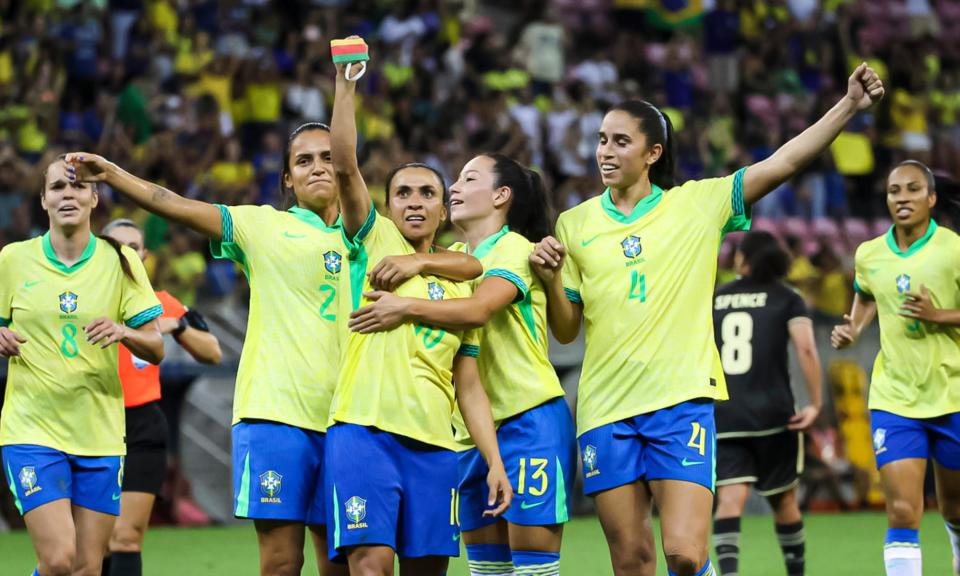World Cup is a chance for women’s football to go mainstream in Brazil

Last month Brazil won the race to host the 2027 Women’s World Cup. The tournament is scheduled to open on 24 June of that year at the Maracanã, the venue for the finals for the 1950 and 2014 men’s editions. The Brazilian Football Confederation (CBF) is confident that hosting it will boost the women’s game in the country, attract new investment and increase public interest.
Brazil’s bid focused on sustainability, with all stadiums already meeting Fifa standards, having been built or renovated for the 2014 men’s World Cup. The organising committee promised free public transport for ticket holders on game days and will arrange official fan festivals, similar to those seen in Australia and New Zealand last year. The bid highlighted the “natural” passion for football in Brazil and emphasised the growth in the women’s game and the benefits for future generations of girls and women.
The CBF expects funding for the event to come from the private sector rather than government sources, addressing one of the major complaints regarding the 2014 men’s World Cup and the 2016 Olympics in Rio de Janeiro. Their goal is to have a self-sustainable tournament, with sponsors and the private sector paying for most of it, rather than relying on taxpayers’ money. Another selling point to Fifa was the low organisational cost compared with the joint bid from Belgium, the Netherlands and Germany.
Unlike the 2014 World Cup, which occurred during a period of political and economic uncertainty, with protests against the event, the 2027 event benefits from having the structure already in place. The benefits could be plentiful. Last year’s co-hosts Australia and New Zealand reported substantial benefits from hosting the tournament, including support for local events and increased participation of women and girls in physical activity.
However, estimating the impact of the Women’s World Cup in Brazil is challenging. Brazilians are, of course, passionate about football but their enthusiasm has historically been connected to the men’s game. For nearly four decades, from 1941 to 1979, women were prohibited by law from playing football with the sport deemed unsuitable for the female body. Despite this, women in the country persevered and fought for the right to play, for support, for visibility and better conditions. They achieved plenty, but there is still a lot of work to do. Hosting a Women’s World Cup could be a crucial step in solidifying the sport as a national passion in Brazil.
All of the stadiums for the 2027 tournament have a capacity of over 40,000, which can be adjusted based on attendance expectations. Ticket prices are expected to start at $17 (£13) – more than twice the cost of the recent friendlies against Jamaica in Salvador and Recife. Still, the Brazilian FA expects more than 2.1m tickets to be sold.
The tournament will be hosted in 10 cities across Brazil’s five geographical regions: Manaus in the north; Cuiabá and Brasília in the mid-west; Porto Alegre in the south; Fortaleza, Recife, and Salvador in the north-east; and São Paulo, Rio de Janeiro, and Belo Horizonte in the south-east. Because of the distances, travel between host cities will primarily be by plane. The costs and the environmental impact will be high but the venues will allow fans to explore the country’s different landscapes, from the Amazon rainforest to the beaches in the north-east, and major tourist destinations such as Rio and São Paulo.
For Brazilians the 2027 World Cup is not only a chance to see the best footballers in the world but also a way to connect with fans from all the participating countries, enjoy the atmosphere in the streets and deepen their love for the sport. During the men’s World Cup 10 years ago, for example, Salvador was vibrant with football as tourists enjoyed local food, drinks and festivities. Many Brazilians may still be traumatised by the 7-1 defeat by Germany but there is nostalgia for those who watched the games on the TV at the stadiums, bars or at the fan fests.
While covering the 2023 World Cup in Australia, I imagined how it would be if Brazil hosted the women’s tournament. Along with watching great football, I enjoyed learning more about the countries, seeing kangaroos, koalas and whales, visiting landmarks in five different cities and enjoying the atmosphere of breathing football for a month. For those planning to attend the World Cup in Brazil, I highly recommend making it a holiday. There’s so much to do, with great football to go with it.
Get in touch
If you have any questions or comments about any of our newsletters please email moving.goalposts@theguardian.com
This is an extract from our free weekly email, Moving the Goalposts. To get the full edition visit this page and follow the instructions.

 Yahoo Sport
Yahoo Sport 






































